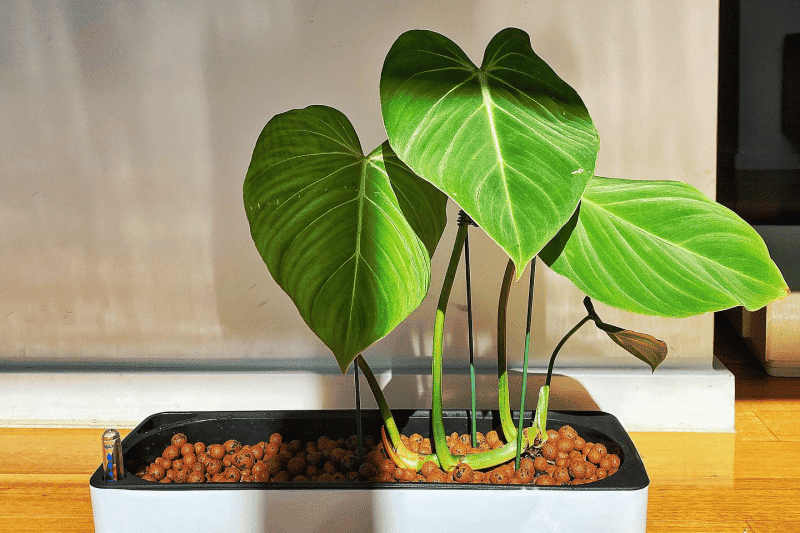LECA is quickly becoming one of the most popular growth mediums for indoor plant lovers. But what is LECA? I mean, what is a growth medium, even, is it different than soil?
If you aren’t sure exactly how Leca works, don’t worry, these are super common questions.
I’ll cover which indoor plants prefer LECA balls, the pros and cons behind using it, and how to transfer plants from soil into a LECA medium so that you avoid root rot.
The promise of LECA is considerable: you no longer have to worry about watering indoor plants, drainage holes, or tracking care for each different houseplant. But… does it hold up?
Table of Contents
What are LECA clay balls?
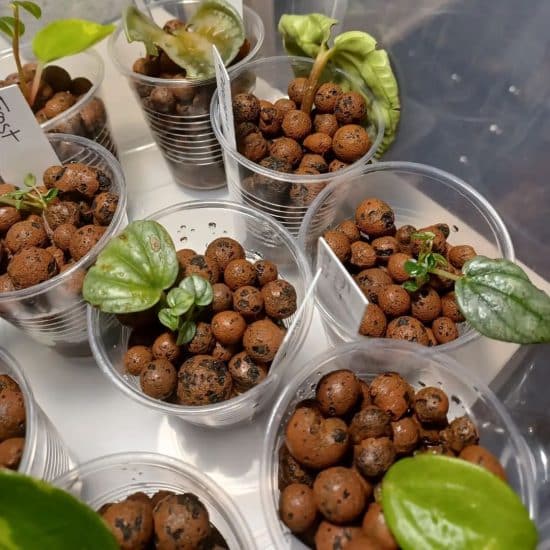
LECA is actually an acronym, standing for Lightweight Expanded Clay Aggregate. You might also see it referred to as clay pebbles, Hydroton, or even grow rocks.
LECA was first created in 1917 (Kansas City, Missouri) as a lightweight insulation material. It was later discovered that indoor plants thrive when grown in this clay aggregate because of fewer pests and less issues with fungus.
The process for creating LECA involves heating clay to 2,000 degrees Fahrenheit in a rotary kiln. As the clay aggregate is heated up, it expands like popcorn and creates small, lightweight clay balls. These balls have a large, porous surface area and this is what makes LECA a very unique growth medium: its ability to wick water naturally as part of the growing medium.
(It’s no surprise these clay balls are a common first introduction to hydroponic gardening.)
For many plants, LECA is a huge upgrade from soil. That large surface area we mentioned is what allows for oxygen to make its way to the roots (the lungs) of a plant, which encourages plant growth and discourages build-up of water and root rot.
As plant roots form around LECA, they’re able to easily wick up the water and nutrients. Since LECA balls are lightweight spheres, they also allow space between them for complex, healthy root structures to form. If you’ve ever had a houseplant in a tiny planter, you’ve seen the damage that that can form from root compaction. This isn’t really a problem with LECA.
LECA is also a much more durable growth medium than soil. Unlike soil, when wet it doesn’t break down, and because it’s not an organic material it doesn’t harbor mold or bacteria.
Getting Started With LECA
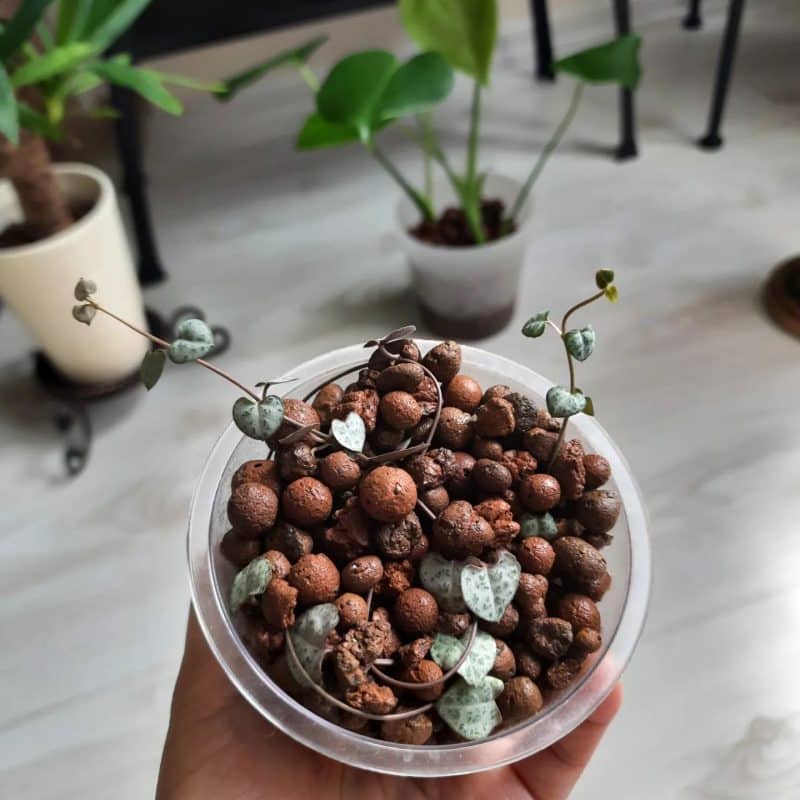
There’s actually not all that much you need beyond the LECA balls, but I want to review the basics real quick before going into the specifics of using LECA (and which plants thrive).
To get started, you’ll need the following supplies:
- LECA. These are the magical clay pebbles that will be your new soil. Common brands are Hydroton or Hydrocrunch, but the generic stuff works great too. If you see pumice advertised and see that it looks similar, it’s because it is! Pumice has very similar properties, and it comes in a variety of sizes with different wicking properties. Our recommended source is here.
- A pot. You have a few options here, but I prefer a self-wicking pot with a small water reservoir. They need less maintenance and don’t have some of the issues you’ll find with glass or transparent containers (mainly algae that grows in the light). Some pots do have tiny transparent windows so you can see the current water levels, I love these. A net pot with a wick works great, too.
- Fertilizer. I go into great depth on this later, but basically any hydroponics fertilizer that you can pick up at any gardening center will work great.
Okay, that’s the short version. Now I’ll cover which plants love to grow in LECA, and the ins and outs of fully (or partially) transitioning to this system.
Plants That Do Well In LECA
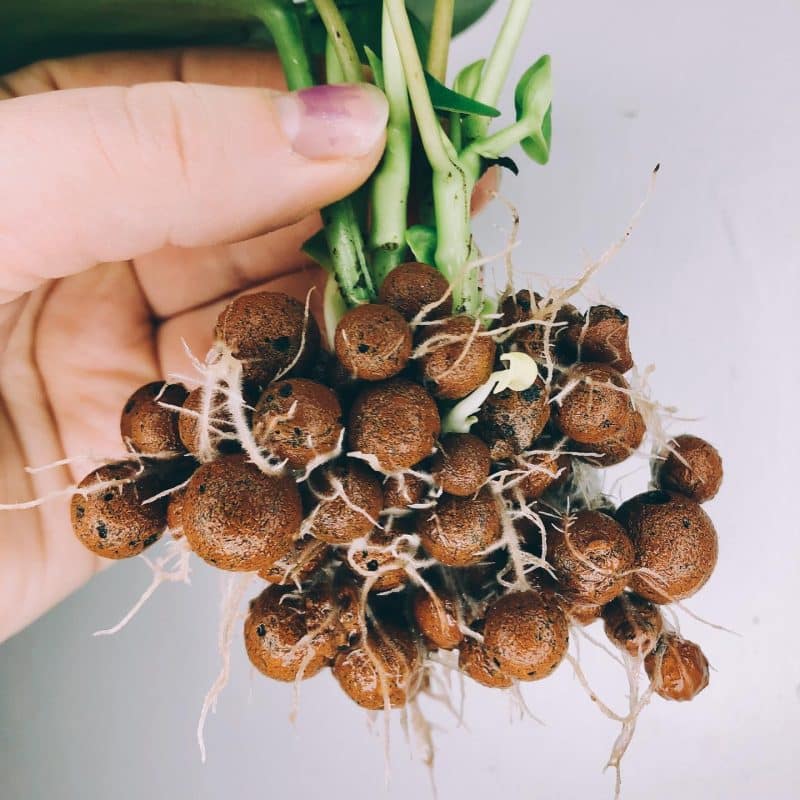
Now that I’ve covered a bit of the story about why LECA and the basics you need to get started, let’s cover the plants that do best in this medium.
For the most part, LECA is best for plants that don’t really require a lot of nutrients. Since LECA doesn’t break down or release nutrients like soil does, all the organic matter has to come from the air or the fertilizer that you add to your houseplants.
Succulents, cacti, air plants, and ferns are some of the ideal candidates for growing in clay balls because they don’t need a lot of organic matter to thrive. Spider plants are another great candidate, as drainage is already pretty simple.
However, you’re not just limited to these options. With a liquid hydroponics fertilizer, just about every plant will thrive in LECA, and taking care of them is a lot simpler. The most popular indoor plants tend to be tropical plants, with very specific humidity, water, and light requirements. While LECA can’t help you out with the light, it does provide a reliable way of distributing water and nutrients to your plants.
Think of them as tiny clay sponges that soak up water and nutrients and release them just as you need them.
(I’ll get into picking out liquid fertilizer a bit later.)
Preparing LECA for the first time
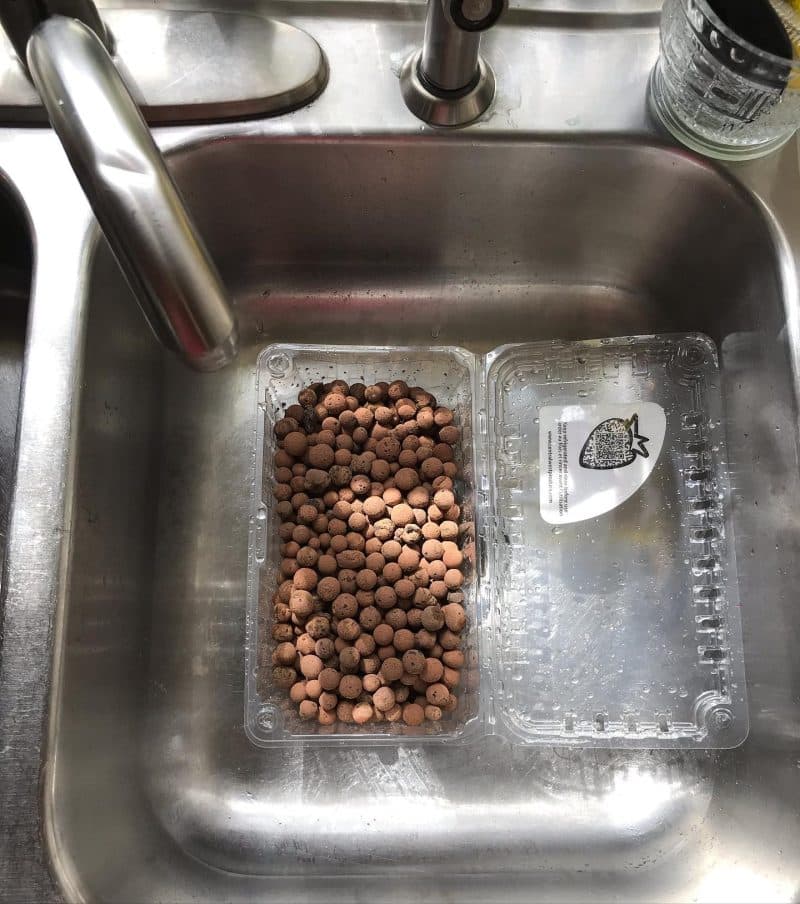
LECA (lightweight expanded clay aggregate) is easy to use, but unlike soil, it does require some preparation. The main reason to start by prepping is to remove variance. There’s a lot that can wrong with growing plants, so let’s make it easy on ourselves.
When one thing is slightly off, everything gets a lot harder to troubleshoot. Example: if you don’t start by soaking the initial mineral content in water (the dissolved solids) can vary. By soaking, we’re fully loading up our clay pebbles with water and we know where we’re starting from.
So let’s get started:
- Start by giving your LECA a rinse, this will clear off any debris and clay dust.
- Soak it overnight, but ideally for 24 hours. If you let it go an extra day or two, this is completely fine, you’ll actually draw more particulate out of the water
- Replace the soaking water with a fresh bath of clean water
- If you’re going to use the LECA right away, you’re all set. If you want to store it for later, it’s time to dry it out. Any wide, open container will work, but you can also use a mesh laundry bag with lots of airflow depending on how much LECA you have.
So… is this really necessary? Maybe. If the plant has a sensitive or fine root system, this may help because you’ll rinse a lot of the loose mineral content out of the water. For sturdier plants, you might be able to skip the above steps.
If you’ve watched videos and didn’t notice them soaking the LECA, it’s probably because they did these steps before starting. Watching LECA dry (or soak) isn’t the most fun, so they might have just forgotten to cover it.
Using fertilizer with LECA
So because we’re using a growing medium that’s naturally inert (clay balls) we have to replace the organic nutrients in the soil somehow, otherwise it wouldn’t be much of a growing medium.
Two options: you can purchase a hydroponics fertilizer or you can mix your own. LECA isn’t quite a hydroponics growing method (some call it semi-hydro compared to full hydroponic systems), but the fertilizers you’ll want are typically sold with that labeling for indoor plants.
If you’re feeling adventurous you can make your own mixture, which involves using a TDS meter (which measures total dissolved solids) and then adding nitrogen, phosphorus, and potassium. That’s a bit beyond the scope of this article (if there’s interest, I can write another article later!), so I’m going to cover using a store-bought hydroponics fertilizer.
If you happen to just be reading this article because you’re curious about LECA (lightweight expanded clay aggregate) but not really wanting to fully commit, you might be interested to learn that LECA balls can help fertilizer reach your plants’ roots more effectively even if you still plant in soil.
That’s right, plants growing in LECA + soil combinations can still benefit. Since LECA is made of these porous clay pebbles, it absorbs the excess liquid fertilizer to release slowly over time as the plant needs it. This means that you’ll have a healthy and robust plant, even if you forget to feed it.
(I know, I know, plant owners never do this when growing houseplants.)
How to Transfer Plants from Soil into LECA
It’s a misconception that there’s a lot of prep work that you need to take care of if you want to grow indoor plants in LECA. Honestly, there’s no really much prep work at all, so I can walk you through the process:
- Start by wetting your LECA, this initial soak prepares both it and your plants for the new growth medium.
- Dig up your plant from its soil, and shake off any excess dirt. It helps for the soil to already be dry.
- For any tiny bits of dirt left over, rinse the roots off in water, even letting them soak for a bit, massaging off any excess soil manually.
- Now place the plant in the LECA, making sure you cover the roots fully.
- All there’s left to do is water the plant, and the excess soil will come off over the next four weeks.
It’s basically the same process for any plant you want to transfer from soil into a new LECA growing medium.
Tip: When filling up the pot, add LECA until it’s about halfway full. Add your plant, then pour more LECA in covering the roots.
If you don’t want to dive fully into 100% LECA, there’s a pretty handy alternative: just start mixing LECA into your plant’s current soil. LECA retains moisture, but also provides aeration and will pull moisture out of the soil through its capillary action. As the soil dries out, the LECA serves as a moisture reserve, watering your plants for you without contributing to root rot.
LECA is one of my favorite growing mediums for houseplants, but most plants will require supplemental nutrients which I’ll cover later on in the article.
Is LECA better than soil?
This really gets at the heart of the matter, and the truth is it depends on the plant. Unsatisfying, I know, but growing plants can be a bit complicated, and plant care is often a moving target.
I’ll quickly cover the pros and cons of using a growing medium like LECA for indoor plants.
Pros:
- Lightweight, not messy
- Doesn’t break down over time or harbor mold/bacteria
- Allows for great oxygenation of plant roots
- Perfect for plants that don’t require a lot of nutrients
- Reusing LECA is totally fine (some suggest boiling it between uses)
- Plants grown in clay balls look super cute!
Cons:
- More expensive than soil when starting out
- Most plants will require that you supplement their nutrients
- Clay pellets are not biodegradable
- You’ll have to relearn some of the plant care basics
LECA is also naturally sterile and pH-neutral, and you don’t have to worry about any foreign elements that have been introduced into the soil. Reducing the number of variables at play always makes things easier when getting started.
If you have an indoor plant that doesn’t require a lot of drainage, LECA can be used as a top dressing. This keeps the plant’s roots moist and prevents the plant from drying out as the LECA serves as a reserve source of water as the soil dries.
Lastly, my favorite reason for using LECA is a bit superficial. The mess soil can create, especially with pets and kids, is pretty substantial. With clay pebbles, you also no longer need to stock six different kinds of potting soil for different house plants.
On the other hand, you will need to stock soil additives (like a hydroponics fertilizer), but they take up a lot less room than huge bags of soil.
Watering plants in LECA
Your instinct will be to water your plants like you used to but as soon as those fingers find their way into the soil… wait that’s not soil, that’s LECA!
So you can’t really check for dry surface. Instead you want to keep a water level and let the plant absorb water as needed.
Quick rule of thumb: the water should fill just below the root line for healthy plant growth. If you let it drop a bit lower, it’s okay because the plant absorbs water out of the clay pellets, giving you a bit more time to calibrate.
Remember, a large point of LECA (beyond aesthetics) is to water less frequently. Try it out and trust the clay!
Propagating plants in LECA
For the most part, I actually don’t recommend using LECA to propagate plants because stem-cutting water propagation is a lot more reliable and easy to keep track of, but it is possible to propagate your plant in these little baked clay balls.
In fact, some plants will do a lot better, like hoyas, pothos, or philodendron.
You’ll want the following supplies:
- LECA clay balls
- A plant propagator or plastic bag
- A plant cutting of your choice
Let’s get started!
- Fill your propagator plastic bags with LECA clay balls, leaving enough space for the cuttings
- Add water until the clay balls are saturated
- Add your cuttings
- Top with water until you reach just below the stem
- Seal the propagator/bag and place it in a warm, humid location. A bathroom near a window can be great.
- Once your root system is established, follow the LECA potting guide above.
The main downside to this method is not being able to easily follow the progress of your propagation like you can with a clear jar and just water, but some plants do a lot better when propagated in LECA.
FAQ
Can I put LECA on top of soil?
Absolutely! If you have a plant that wants to stay moist and you don’t want to frequently water, LECA can serve as a water reserve so that as the soil dries out, the plant still has access to moisture.
Is LECA the same as clay pebbles?
Yes, they are the same thing!
Do you have to clean LECA?
You don’t need to clean LECA when you first get it, but you will need to prepare it before using LECA by soaking for around 15 minutes.
Is it okay to use LECA balls with a potting mix?
Absolutely. As indoor gardeners know, potting mix can often be too dense and slow draining. Using LECA (with its porous surface that can absorb moisture directly) along with standard potting soil (with proper drainage) will result in the perfect growing environment for most houseplants.
LECA balls can also help you save space. Because you can add them to regular potting soil, you can stock fewer varieties in your house and just mix LECA in as needed for aeration.

